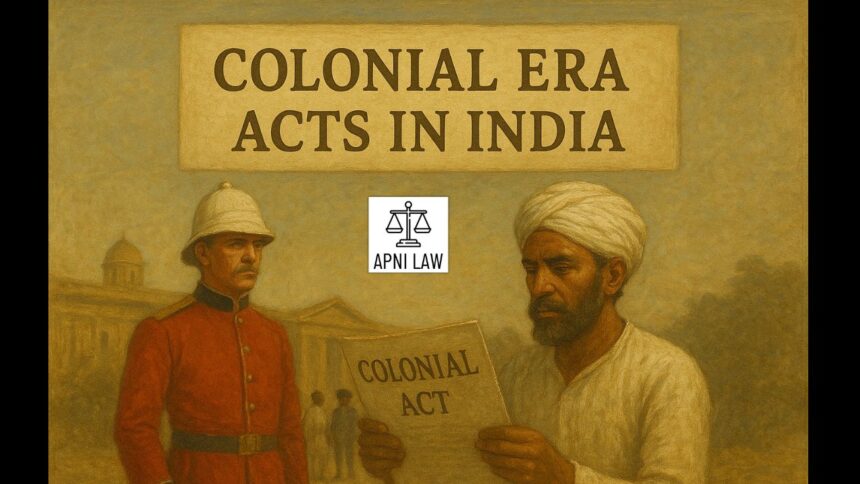Introduction
The Indian Councils Act of 1861 stands as a turning point in the history of British colonial administration in India. After the Revolt of 1857, the British Crown assumed direct control of India through the Government of India Act 1858. However, one criticism of Company rule and early Crown rule was the complete exclusion of Indians from governance. The Indian Councils Act of 1861 marked the first attempt to address this gap by allowing Indian representation, albeit in a limited way, in the legislative process. Though symbolic at first, this Act became the stepping stone for future reforms that gradually expanded Indian participation in law-making.
Background to the Indian Councils Act 1861
After the Revolt of 1857, Britain realized that ruling India without involving Indians in governance was unsustainable. The Queen’s Proclamation of 1858 promised to respect Indian traditions, customs, and rights. To win back Indian loyalty, the British government decided to make cautious reforms.
The British administration understood that involving Indian elites, particularly princes, landlords, and educated Indians, in governance would reduce opposition and give legitimacy to Crown rule. The Indian Councils Act of 1861 was thus framed as a measure to introduce Indians into the legislative councils. At the same time, it consolidated the power of the Viceroy, ensuring that Britain maintained firm control.
Provisions of the Indian Councils Act 1861
The Indian Councils Act of 1861 introduced several important changes to India’s governance.
The most significant provision was the inclusion of Indians in legislative councils. For the first time, the Viceroy was empowered to nominate Indians as non-official members of his expanded legislative council. This was a historic move, though the number of Indians was small, and their role was limited to advice rather than decision-making. The first Indians nominated included Raja of Benaras, the Maharaja of Patiala, and Sir Dinkar Rao.
The Act also expanded the Governor-General’s Council for legislative purposes. The Council could now include between six and twelve additional members. These members participated only in law-making and not in executive functions, marking the beginning of a separation of powers in colonial governance.
Another key reform was the restoration of legislative powers to provincial governments such as Bombay and Madras. Earlier, under the Charter Act of 1833, these provinces had lost legislative authority, with all powers centralized in Calcutta. The 1861 Act reversed this trend, giving provinces limited autonomy in making laws for local issues. This decentralization helped improve governance across India’s diverse regions.
The Act also empowered the Viceroy to issue ordinances during emergencies. Such ordinances carried the force of law for six months, reinforcing the Viceroy’s dominance over Indian administration.
Impact of the Indian Councils Act 1861
The Indian Councils Act of 1861 had far-reaching consequences for Indian governance. By including Indians, even in a token capacity, the Act introduced the idea that Indians could participate in law-making. For the first time, Indian voices, though restricted, entered the legislative process. This symbolic gesture had significant psychological impact, as it gave Indians a foothold in governance.
The expansion of legislative councils also marked the beginning of modern law-making in India. The separation of legislative and executive functions, though limited, allowed for more focused debates and the drafting of specific laws. This created the foundation for later legislative reforms.
The decentralization of legislative powers to provinces like Bombay and Madras improved administrative efficiency. It recognized that India’s diversity required regional solutions rather than a one-size-fits-all model. This principle of decentralization continued to shape Indian governance even after independence.
However, the Act’s real significance lay in its long-term impact. Though Indians had little real power, the precedent it set fueled demands for greater representation. Later reforms, including the Indian Councils Acts of 1892 and 1909, expanded these rights, eventually paving the way for responsible government in the twentieth century.
Criticism of the Indian Councils Act 1861
Despite its importance, the Act faced criticism. Indian participation in councils was minimal and restricted to elites chosen by the Viceroy. Ordinary Indians had no say in the process. Moreover, the nominated Indians had only advisory roles, with no real influence on decisions.
The Act also concentrated significant powers in the hands of the Viceroy. His ability to issue ordinances reduced the role of legislative councils, making them more ceremonial than functional. Critics argued that the Act was less about empowering Indians and more about pacifying them after the 1857 Revolt.
In short, while the Act appeared progressive, it remained a cautious and conservative step, designed to maintain British dominance while giving Indians a taste of participation.
FAQs on Indian Councils Act 1861
1. Why was the Indian Councils Act of 1861 important?
It was the first Act that allowed Indians to be nominated to legislative councils, marking their entry into the law-making process, though in a limited way.
2. Who were the first Indians nominated under the Act?
The Raja of Benaras, the Maharaja of Patiala, and Sir Dinkar Rao were among the earliest Indians nominated to the legislative council.
3. How did the Act change provincial governance?
It restored legislative powers to provinces like Bombay and Madras, allowing them to make laws for local needs and reducing centralization.
Conclusion
The Indian Councils Act of 1861 was a landmark in India’s constitutional history. It marked the first step towards involving Indians in legislation, even though their role was limited and largely symbolic. By expanding councils, decentralizing legislative authority, and introducing nominated Indian members, the Act laid the foundation for India’s gradual transition to participatory governance.
Although criticized for concentrating power in the hands of the Viceroy and offering only token representation, the Act set the stage for future reforms. It showed that Indians could no longer be entirely excluded from governance and that their participation, however limited, was essential to maintain stability. In hindsight, the Act represents both British caution and Indian aspiration, a cautious reform that sparked the long struggle for greater representation and ultimately for independence.
For any specific query call at +91 – 8569843472








